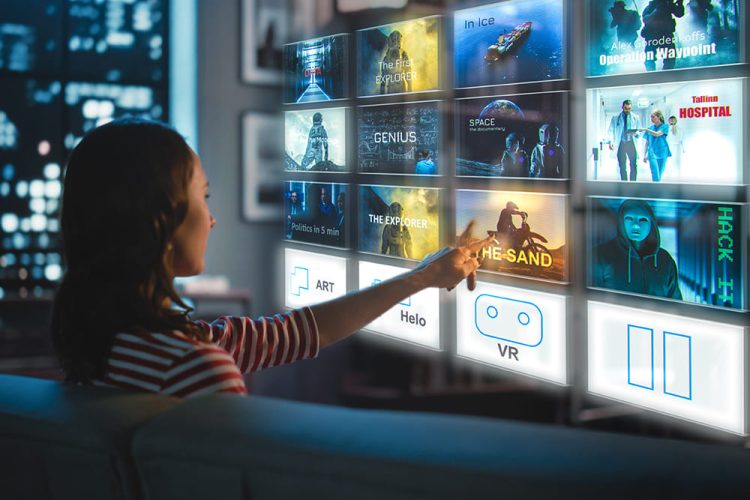Introduction: The Fusion of Virtual and Real Worlds
The world of entertainment has undergone a revolutionary transformation in recent years, largely driven by the rise of Augmented Reality (AR) and Mixed Reality (MR) technologies. These innovations have blurred the lines between the virtual and physical realms, offering users novel ways to engage with content and interact with their surroundings. By overlaying virtual elements on the real world, these technologies have given rise to a new era of interactive and immersive entertainment experiences.
In this article, we explore how applications that combine virtual elements with the real world are reshaping entertainment. We will delve into the applications of Augmented Reality (AR) across various entertainment sectors, from gaming to live performances and interactive media. Additionally, we will examine the impact of these technologies on user experience, the potential for new forms of content creation, and the future of entertainment as we know it.
1. What Is Augmented Reality and How Does It Enhance Entertainment?
1.1 Defining Augmented Reality (AR)
Augmented Reality (AR) refers to the technology that overlays digital content—such as images, sounds, or information—onto the physical world. Unlike Virtual Reality (VR), which creates entirely digital environments, AR enhances the real world by blending virtual objects with real-world scenes. This blending allows for a more interactive and immersive experience.
The typical AR experience is facilitated through devices such as smartphones, tablets, and AR glasses. The most popular form of AR application today is mobile AR, where the camera of a device scans and maps the environment, then superimposes digital elements on the live view. Apple’s ARKit and Google’s ARCore are examples of platforms that enable developers to create AR experiences on smartphones.
1.2 How AR Transforms Entertainment
AR takes entertainment beyond passive consumption by making it interactive. Instead of watching a screen, users engage with their environment, incorporating both virtual and real elements into a shared experience. This fusion opens up new opportunities for storytelling, gameplay, and audience engagement, making entertainment more dynamic and personal.
2. Augmented Reality in Gaming: A New Dimension of Play
2.1 The Rise of AR Games
In recent years, AR gaming has become one of the most compelling examples of how virtual elements can blend seamlessly with the real world. AR gaming enables players to interact with their environment while immersing themselves in digital content. One of the most iconic examples is Pokémon GO, which became a global sensation upon its release in 2016.
In Pokémon GO, players use their smartphones to locate and capture virtual Pokémon in real-world locations. By leveraging AR technology, the game merges the virtual world of Pokémon with real-world landmarks, creating a dynamic and highly engaging experience. This integration encourages players to get outside, explore their surroundings, and interact with others in real-time, offering a fresh twist on traditional gameplay.
Other notable AR games include Ingress, a mobile game where players interact with virtual portals located in real-world locations, and Harry Potter: Wizards Unite, which uses AR to let players cast spells and collect magical creatures in their local environment.
2.2 Advantages of AR Gaming
- Immersive Interaction: AR gaming makes players feel as though they are part of the game world by allowing them to physically interact with their surroundings.
- Social Connectivity: AR games like Pokémon GO encourage social interaction by allowing players to meet, team up, and engage in real-time activities.
- Health Benefits: Many AR games promote physical activity by encouraging players to walk, explore, and be active in real-world environments.
2.3 Challenges and Opportunities
While AR gaming has gained popularity, it still faces challenges. For instance, the reliance on smartphones limits the immersion compared to VR, and outdoor gameplay can be hindered by weather or terrain. However, these challenges also present opportunities for future development. The future of AR gaming will likely involve wearable AR devices, such as smart glasses or contact lenses, that allow users to interact with virtual elements without needing to hold a phone or tablet.

3. Augmented Reality in Movies and Television: The Future of Interactive Storytelling
3.1 Interactive Movies and TV Shows
Beyond gaming, AR is also making its way into movies and television. Traditional storytelling has primarily been linear, with the audience watching a narrative unfold on a screen. However, AR has the potential to turn storytelling into an interactive, personalized experience.
One example of this is the Bandersnatch episode of the popular series Black Mirror, which introduced an interactive narrative where viewers could make choices that influenced the storyline. While this episode was not strictly an AR experience, it pointed to the future of interactive storytelling, where audiences become part of the narrative. With AR, this kind of interaction could be taken even further, blending digital characters with real-world settings and allowing users to shape the environment around them.
3.2 AR in Live Performances
AR is also transforming the way audiences experience live performances, including concerts, theater, and opera. AR glasses or smartphones can enhance the visual experience by projecting digital content onto physical stages, enriching the live performance with virtual effects. For example, virtual characters or 3D graphics can be superimposed onto the stage, creating an enriched, interactive experience for the audience.
Musicians have also started using AR to enhance their concerts. In 2020, Travis Scott held a virtual concert inside the video game Fortnite, where millions of players were able to attend a live, AR-infused performance in a virtual environment. This fusion of music and gaming provides an immersive way for artists to connect with global audiences.
3.3 Immersive Movie Experiences
With the help of AR, movies can go beyond traditional storytelling and give audiences the chance to interact with the film’s environment. 360-degree video and AR-enhanced film screenings enable viewers to experience the movie from different perspectives, immersing them in the story in ways that were previously unimaginable. Services like Within and Oculus TV provide access to immersive, interactive films and documentaries, where users can explore virtual environments as they watch.
4. Augmented Reality in Theme Parks and Live Events
4.1 Theme Parks and AR Attractions
Theme parks have been early adopters of AR technology, using it to create more immersive and interactive attractions. For example, Disney’s MagicBand system integrates AR and IoT (Internet of Things) to offer personalized experiences for visitors. The system can be used to interact with digital characters, explore hidden virtual content in the park, and track the guest’s preferences.
One of the most well-known AR experiences in a theme park is the Star Wars: Galaxy’s Edge attraction at Disneyland, where AR is used to allow guests to interact with virtual elements within the Star Wars universe. Visitors can use AR-enabled devices to scan the environment, uncover hidden objects, or interact with characters in real-time.
4.2 AR in Live Sports and Concerts
AR is also transforming the way we experience live sports and concerts. Through AR-enabled broadcast systems, viewers can see real-time statistics overlaid on live events, such as player stats, scores, and game insights. This enhances the viewing experience and allows fans to engage with content in a more interactive way.
At live concerts, AR can be used to project holograms of performers, create interactive environments, or allow fans to interact with virtual elements on the stage. The future of AR in entertainment promises even more immersive and personalized experiences for attendees, blurring the lines between the virtual and real worlds.
5. The Future of AR and Virtual Elements in Entertainment
5.1 The Metaverse and Virtual Worlds
Looking forward, AR is poised to play a central role in the development of the Metaverse—a fully immersive digital universe where users can interact with virtual worlds and other users. The Metaverse promises to combine virtual and real-world experiences in unprecedented ways, allowing users to attend virtual concerts, shop, socialize, and even work in entirely digital environments. As AR technology evolves, the potential for creating shared, immersive virtual worlds grows exponentially.
5.2 Wearable AR Technology
The future of AR in entertainment will heavily rely on wearable devices, such as smart glasses, contact lenses, and headsets. These devices will make AR more accessible and more immersive, allowing users to experience AR in a hands-free, seamless way. As wearable AR technology improves, we can expect to see entertainment experiences that integrate AR more naturally into our daily lives.
5.3 AI and AR Integration
Artificial intelligence (AI) will also play a key role in the future of AR, enabling smarter and more dynamic interactions. AI can help create personalized experiences by learning from a user’s behavior and preferences, and adapting AR content accordingly. This integration will allow for more engaging, tailored entertainment experiences that evolve with the user.
Conclusion: The New Era of Entertainment
Augmented Reality is reshaping the entertainment landscape by blending virtual elements with the real world. From gaming to live performances, movies, and theme parks, AR has opened up a world of possibilities for interactive, immersive entertainment experiences. By allowing users to engage with digital content in a way that feels natural and intuitive, AR is not just enhancing entertainment—it’s redefining it.
As technology advances, the future of AR promises even more innovative ways to combine virtual elements with the physical world, creating experiences that are personalized, social, and highly interactive. The convergence of AR with other technologies, such as AI, 5G, and wearable devices, will further fuel this transformation, pushing the boundaries of what we thought was possible in entertainment.
With each new AR application, we move closer to a future where entertainment is not just something we observe—it’s something we actively participate in, live in, and shape ourselves.











































